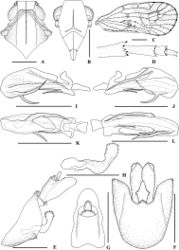Kirbyana
| Notice: | This page is derived from the original publication listed below, whose author(s) should always be credited. Further contributors may edit and improve the content of this page and, consequently, need to be credited as well (see page history). Any assessment of factual correctness requires a careful review of the original article as well as of subsequent contributions.
If you are uncertain whether your planned contribution is correct or not, we suggest that you use the associated discussion page instead of editing the page directly. This page should be cited as follows (rationale):
Citation formats to copy and paste
BibTeX: @article{Zhi2021ZooKeys1037, RIS/ Endnote: TY - JOUR Wikipedia/ Citizendium: <ref name="Zhi2021ZooKeys1037">{{Citation See also the citation download page at the journal. |
Ordo: Hemiptera
Familia: Cixiidae
Name
Kirbyana Distant, 1906 – Wikispecies link – Pensoft Profile
- Kirbya Melichar, 1903: 37, preoccupied by Kirbya Robineau-Desvoidy, 1830 (Diptera).
- Kirbyana Distant, 1906a: 262, nom. nov. for Kirbya Melichar, 1903.
- Kirbyella Kirkaldy, 1906: 248, synonymised by Distant 1906b[1]: 274.
- Saccharias Kirkaldy, 1907: 125, synonymised by Fennah 1980[2]: 239.
- Commolenda Distant, 1911: 741, synonymised by Fennah 1978[3]: 211.
Type species
Kirbya pagana Melichar, 1903 (original designation by Distant).
Diagnosis
Head. Head including eyes slightly narrower than pronotum. Vertex in profile horizontal, in same line as thorax, meeting frons abruptly nearly at 90°; subapical carina absent. Frons somewhat longer than broad or as long as wide; median carina present; anterior margin angularly emarginate or transverse; position of maximum width of frons more or less at the level of antennae. Median ocellus absent. Subapical segment of rostrum 2.5 times longer than apical segment.
Thorax. Pronotum very narrow, scarcely half as long as vertex in midline. Mesonotum nearly twice as long as pronotum and vertex together. Forewing with the eucarpian basal concavity of the anterior margin of the forewings, also slightly concave at node level. Hindwing with simple radius (R). Hind tibia lacking lateral spines. Metatibiotarsal formula: 6/8‒11/9‒11.
Male genitalia. Pygofer symmetrical and prolonged with symmetrical lateral lobes in lateral view. Medioventral process thumb-like in lateral view. Anal segment short and stout. Gonostyli relatively small and symmetrical. Aedeagus slender and endosoma of aedeagus with spinose processes.
Female genitalia. Ovipositor elongate, orthopteroid and slightly curved upwards; anal segment square or rectangular in dorsal view; 9th tergite without wax plate. Posterior vagina with sclerites.
Distribution
Australian and Oriental regions.
Checklist and distributions of species of Kirbyana Distant K. aspina Zhi & Chen, sp. nov.; China (Hunan).
K. australis (Muir, 1913); Australia (Northern Territory; Queensland).
K deusta (Distant, 1911); Central India.
K deventeri (Kirkaldy, 1907); Indonesia (Java).
K. furcata Zhi & Chen, sp. nov.; China (Guangxi, Yunnan).
K javana Muir, 1913; Indonesia (Java).
K lini Tsaur & Hsu, 2003; China (Taiwan).
K pacifica Emeljanov & Hayashi, 2007; China (Taiwan), Japan (Ryukyu Islands).
K. pagana (Melichar, 1903); Sri Lanka (Peradeniya).
K pratti Muir, 1913; Malaysia (Parit Buntar).
K pratti thyas Fennah, 1978; Vietnam (Cuc-phuong Province, Ninh Binh).
Taxon Treatment
- Zhi, Y; Yang, L; Chen, X; 2021: Two new bamboo-feeding species of the genus Kirbyana Distant, 1906 from China (Hemiptera, Fulgoromorpha, Cixiidae) ZooKeys, 1037: 1-14. doi
Images
|
Other References
- ↑ Distant W (1906b) Bibliographical and nomenclatorial notes on the Rhynchota.The Entomologist39: 274–275.
- ↑ Fennah R (1980) The genus Bajauana and two allied new genera in New Guinea (Fulgoroidea: Cixiidae).Pacific Insects22: 237–328.
- ↑ Fennah R (1978) Fulgoroidea (Homoptera) from Vietnam.Annales Zoologici (Warszawa)34(9): 207–279.
- ↑ Löcker B, Fletcher M, Gurr G (2010) Taxonomic revision of the Australian Eucarpiini (Hemiptera: Fulgoromorpha: Cixiidae) with the description of nine new species.Zootaxa2425: 1–31. https://doi.org/10.11646/zootaxa.2425.1.1
- ↑ Kirkaldy G (1907) Descriptions et remarques sur quelques Homoptères de la famille des Fulgoroideae vivant sur la canne à sucre. Annales de la Société entomologique de Belgique.Bruxelles51: 123–127.
- ↑ Tsaur S, Hsu T (2003) The Cixiidae of Taiwan, Part VII: Tribe Pintaliini (Hemiptera: Fulgoroidea).Zoological Studies42(3): 431–443.
- ↑ Emeljanov A, Hayashi M (2007) New Cixiidae (Hemiptera, Auchenorrhycha) from the Ryukyus, Japan.Japanese Journal of Systematic Entomology13(1): 127–140.

